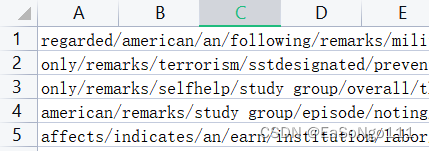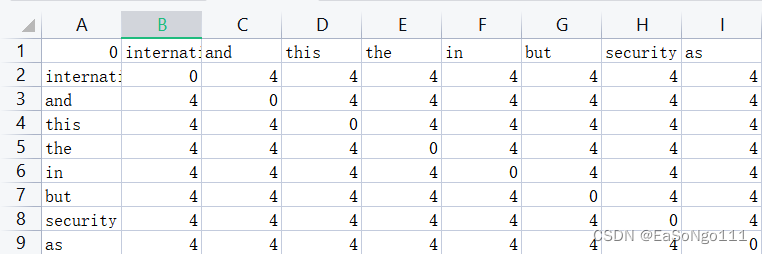python共词矩阵分析结果一步到位

import os
import re
import pandas as pd
from PyPDF2 import PdfFileReader
import string
import yakeif __name__ == '__main__':# 运行第一部分代码pdf_files_path = 'C:/Users/win10/Documents/美国智库/pdf_files'# 定义一个函数,用于读取PDF文件并将其转化成文本def read_pdf(filename):filepath = os.path.join(pdf_files_path, filename)with open(filepath, 'rb') as f:pdf = PdfFileReader(f)text = ''for i in range(pdf.getNumPages()):page = pdf.getPage(i)text += page.extractText()return text# 读取Excel文件df = pd.read_excel(r'C:\\Users\\win10\\Desktop\\2022.xlsx')# 循环遍历每行数据for index, row in df.iterrows():# 判断是否有PDF文件名if pd.notna(row['pdf_filename']):try:# 尝试读取PDF文件并识别成文字text = read_pdf(row['pdf_filename'])except:# 读取失败则跳过continue# 替换art_content列的值为PDF中的文字df.at[index, 'art_content'] = text# 对art_content列进行分词stop_words = ["d"]def phrase_extract(text):text = text.lower()custom_kw_extractor = yake.KeywordExtractor(top=10, lan="en")keywords = custom_kw_extractor.extract_keywords(text)phrase_list = []for keyword, score in keywords:if len(keyword.split(' ')) > 1:phrase_list.append(keyword.lower())phrases_list = []for phrase in phrase_list:for i in range(0, len(text.split(phrase)) - 1):phrases_list.append(phrase)return phrases_listdef segment(text):phrases_list = phrase_extract(text)# word_tokens = nltk.tokenize.word_tokenize(text.strip())word_list = []for i in text.split(' '):word_list.append(i)table = str.maketrans('', '', string.punctuation)tokens = [w.translate(table) for w in word_list]# tokens = [w.translate(table) for w in word_tokens]tokens = [word for word in tokens if word.isalpha()]tokens = [w for w in tokens if not w in stop_words]tokens = [word for word in tokens if len(word) > 1]tokens = list(set(tokens+phrases_list))return tokensdf['col'] = df['art_content'].apply(lambda x: '/'.join(segment(x)).lower())df['col'].to_excel(r'C:\\Users\\win10\\Desktop\\结果P1.xlsx', index=False, header=False)# -*- coding: utf-8 -*-
import numpy as np
import time
from pprint import pprint as p
import pandas as pddef log(func):def wrapper(*args, kwargs):now_time = str(time.strftime('%Y-%m-%d %X', time.localtime()))print('------------------------------------------------')print('%s func [%s] called' % (now_time, func.__name__))print('# %s' % func.__doc__)print('%s returns:' % func.__name__)re = func(*args, kwargs)p(re)return rereturn wrapperdef readxls(path):import xlrdxl = xlrd.open_workbook(path)sheet = xl.sheets()[0]data = []for i in range(0, sheet.ncols):data.append(list(sheet.col_values(i)))return (data[0])@log
def get_set_key(data, threshold=2):'''选取频数大于等于Threshold的关键词构建一个集合,用于作为共现矩阵的首行和首列'''all_key = '/'.join(data)key_list = [it.strip() for it in all_key.strip().split('/')]keys = set(key_list)dic = dict(zip(keys, [key_list.count(k) for k in keys]))wf = {k: v for k, v in dic.items() if k != '' and v >= threshold}set_key_list = []for a in sorted(wf.items(), key=lambda item: item[1], reverse=True):set_key_list.append(a[0])return set_key_list@log
def format_data(data, set_key_list):'''格式化需要计算的数据,将原始数据格式转换成二维数组'''formated_data = []for ech in data:ech_line = str(ech).split('/')temp = [] # 筛选出format_data中属于关键词集合的词for e in ech_line:if e in set_key_list:temp.append(e)ech_line = tempech_line = list(set(filter(lambda x: x != '', ech_line))) # set去掉重复数据formated_data.append(ech_line)return formated_data# @log
def build_matirx(set_key_list):'''建立矩阵,矩阵的高度和宽度为关键词集合的长度+1'''edge = len(set_key_list) + 1# matrix = np.zeros((edge, edge), dtype=str)matrix = [[0 for j in range(edge)] for i in range(edge)]return matrix@log
def init_matrix(matrix, set_key_list):'''初始化矩阵,将关键词集合赋值给第一列和第二列'''matrix[0][1:] = np.array(set_key_list)matrix = list(map(list, zip(*matrix)))matrix[0][1:] = np.array(set_key_list)return matrix@log
def count_matrix(matrix, formated_data):'''计算各个关键词共现次数'''keywordlist = matrix[0][1:] # 列出所有关键词appeardict = {} # 每个关键词与 [出现在的行(formated_data)的list] 组成的dictionaryfor w in keywordlist:appearlist = []i = 0for each_line in formated_data:if w in each_line:appearlist.append(i)i += 1appeardict[w] = appearlistfor row in range(1, len(matrix)):# 遍历矩阵第一行,跳过下标为0的元素for col in range(1, len(matrix)):# 遍历矩阵第一列,跳过下标为0的元素# 实际上就是为了跳过matrix中下标为[0][0]的元素,因为[0][0]为空,不为关键词if col >= row:# 仅计算上半个矩阵if matrix[0][row] == matrix[col][0]:# 如果取出的行关键词和取出的列关键词相同,则其对应的共现次数为0,即矩阵对角线为0matrix[col][row] = 0else:counter = len(set(appeardict[matrix[0][row]]) & set(appeardict[matrix[col][0]]))matrix[col][row] = counterelse:matrix[col][row] = matrix[row][col]return matrixdef main():keyword_path = r'C:\\Users\\win10\\Desktop\\结果P1.xlsx'output_path = r'C:\\Users\\win10\\Desktop\\结果P2.xlsx'data = readxls(keyword_path)set_key_list = get_set_key(data)formated_data = format_data(data, set_key_list)matrix = build_matirx(set_key_list)matrix = init_matrix(matrix, set_key_list)result_matrix = count_matrix(matrix, formated_data)print(result_matrix)pd.DataFrame(result_matrix).to_excel(output_path,index=False)# np.savetxt(output_path, result_matrix, fmt=('%s,' * len(matrix))[:-1])if __name__ == '__main__':main()import pandas as pdif __name__ == '__main__':# 读取 Excel 文件并将每个单元格转换为整数类型df = pd.read_excel(r'C:\\Users\\win10\\Desktop\\结果P2.xlsx', index_col=0)# df = df.astype(int)# 定义一个空字典用于存储词组搭配及其出现次数co_occurrence_dict = {}# 遍历共现矩阵中每个单元格,并将词组搭配及其出现次数存储到字典中for i in range(df.shape[0]):for j in range(i, df.shape[1]): # 只遍历矩阵对角线以上的所有元素# 获取当前单元格的值count = df.iloc[i, j]# 获取当前单元格所对应的行和列的单词word1 = df.index[i]word2 = df.columns[j]# 构造词组搭配collocation = (word1, word2)# 更新字典中的词组搭配及其出现次数if collocation in co_occurrence_dict:co_occurrence_dict[collocation] += countelse:co_occurrence_dict[collocation] = count# 将词组搭配及其出现次数转换为 DataFrame 类型result = pd.DataFrame([(collocation[0], collocation[1], count) for collocation, count in co_occurrence_dict.items()], columns=["Word1", "Word2", "Count"])# 将 DataFrame 写入到新的 Excel 表中result.to_excel(r'C:\\Users\\win10\\Desktop\\结果P3.xlsx', index=False)每个函数的作用:
- read_pdf():读取 PDF 文件并将其转换成文本,返回字符串类型的文本。
- phrase_extract():利用 YAKE 模型提取出文本中的关键词短语。默认提取前 10 个得分最高的关键短语,返回一个列表。
- segment():将原始文本分成单词和短语,返回一个列表。
- get_set_key():将所有输入的文本中出现频数大于等于 threshold 的单词构建成一个集合,用于作为共现矩阵的首行和首列。返回一个列表。
- format_data():将原始数据格式转换成二维数组。返回一个列表。
- build_matrix():建立矩阵,矩阵的高度和宽度为关键词集合的长度+1。返回一个二维列表。
- init_matrix():初始化矩阵,将关键词集合赋值给第一列和第二列。返回一个二维列表。
- count_matrix():计算各个关键词共现次数,生成一个共现矩阵,返回一个二维列表。
- main():主函数,将以上函数调用整合在一起,并将结果写入 Excel 文件。
- readxls():读取 Excel 文件数据并返回一个列表,每个列表项为单元格中的字符串。
- log():一个装饰器函数,用于记录函数调用情况并输出结果。
- pd.read_excel():读取 Excel 文件,返回一个 Pandas DataFrame。
- np.array():将输入转换为 NumPy 数组。
- np.zeros():生成一个全 0 矩阵。
- map():对序列中的每个元素都执行相同的操作,返回一个可迭代对象。
- set():创建一个无序不重复元素集合。
- dict():创建一个字典。
- filter():过滤掉不符合规则的元素,返回一个可迭代对象。
- list():将输入转换为列表类型。
- zip():将多个序列压缩成一个元组列表。
- sorted():对列表进行排序。
- pd.DataFrame():将输入转换为 Pandas DataFrame 类型。
- to_excel():将数据保存为 Excel 格式。
思路过程:
1.首先,使用 PyPDF2 库读取 PDF 文件并将其转化为文本。
2.读取 Excel 文件,并循环遍历每行数据,尝试读取 PDF 文件并识别成文字,并将 art_content 列的值替换为 PDF 中的文字。
3.对 art_content 列进行分词处理,使用 yake 库提取关键词,并将处理结果写入到结果P1.xlsx文件中。
4.读取 P1 文件中的关键词,并将其转换为矩阵。
5.定义词组搭配的字典 co_occurrence_dict,遍历共现矩阵中每个单元格,并将词组搭配及其出现次数存储到字典中。
6.将得到的词组搭配及其出现次数转换为 DataFrame 类型
结果
P1
P2
P3
